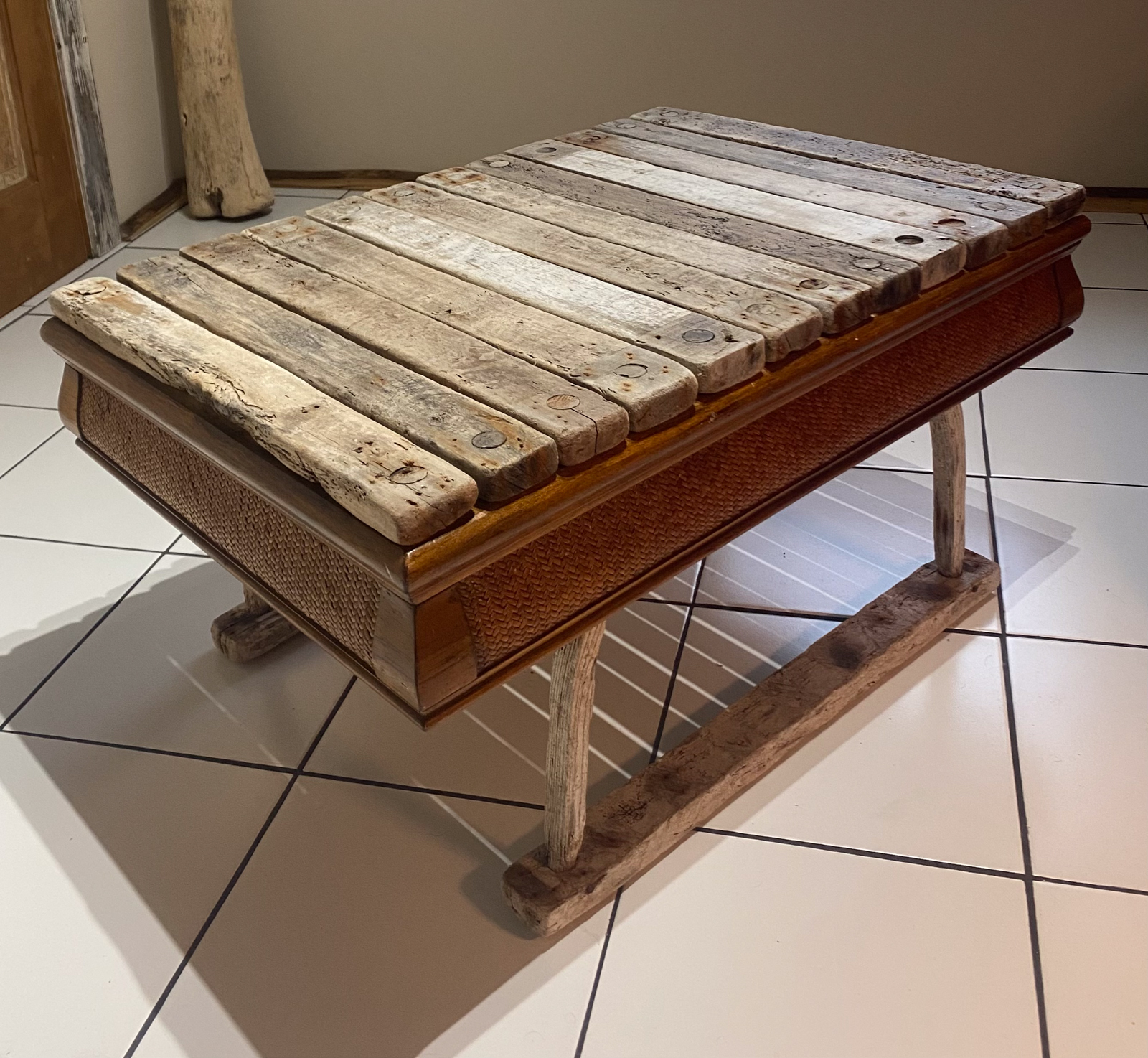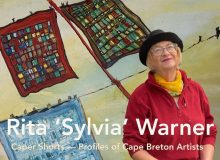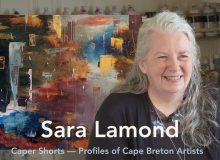Mark Connors’ Lobsters
Being immersed in Nature has always been critical to Mark Connors’ artistic and spiritual well-being
Mark Connors has been painting a lot of lobsters lately, mostly in strong primary colours — reds and blues, with rich textural effects. Retired, single again and living in an Acadian fishing village on an island off the coast of Cape Breton, this was never the answer to ‘where do you see yourself in five years?’ But Mark has settled in and is back into painting after a long hiatus, his inspiration and entry point being the bleached lobster bodies and other debris he’s found washed up on the shore. Pivoting from the abstract expressionism of his earlier work in the 1990’s, “I turned toward more representational art to tell the story more directly of lobster fishing and Acadian culture.”
There is much to energize an artist here. From the dormer window of his studio on the third floor of his foursquare style house in Petit-de-grat you can see the bridge, the deep blue water at the head of the harbour, colorful fishing boats, rugged rocky outcrops and hardy, scrubby plants. And he’s been bringing the environment indoors, renovating his house with carefully chosen found objects, reclaimed wood for cabinets, driftwood railings, and live-edge scrap from a local lumber mill for trim to make the house his own to stunning original effect.

A relative newcomer to Cape Breton, Mark has been living here full time for a couple of years now. Originally from Sudbury, Ontario, he and his then wife bought the house here three years ago motivated by a tip from a neighbour back in Huntsville that property was cheap here. Eventually he and his wife parted ways. He got the house here and is now enthusiastically exploring his environment and finding his way.

The need to be immersed in Nature
Being immersed in Nature has always been critical to his development both artistically and intellectually. As a child he loved to explore the natural world on a minute scale. He showed us an old microscope that he had kept from his youth and a slide that he made of a flea. It was a rich red brown colour and beautiful in its complexity. It was obvious how studying Nature in this way informs his very detailed and precise art work in the present.
“I always loved being in Nature,” he said. “When I was a kid I used to hunt crayfish in the streams.” He says he even kept one in an aquarium over the winter, feeding it turtle food. Flea, crayfish, lobster. There seems to be a progression of invertebrate study and appreciation here.

He says if his art does anything he would like it to inspire people to get out of their cars or boats and get their boots on the ground or their feet into the water. As an adult Mark bought a place off-grid near Huntsville, about three hours from Toronto, where he could be as close to pure Nature as one can. But he went further. He said, “I love Nature so much when I was 25 I had to go to the Galapagos Islands.” The Galapagos was made famous by naturalist Charles Darwin’s trip in the HMS Beagle. “What a place. You know, the tortoises there, the Blue Footed Boobies… the Flightless Cormorants. Just beautiful.”
Painting is his primary creative outlet
Trained as a graphic designer back in the pre-computer days, he has had several periods in his life where painting dominated. Other creative outlets he has are writing fiction and poetry, furniture making and music. And home reno. His painting, though, has had the most success. He’s had shows in Toronto, Huntsville, Bracebridge, Sudbury and Whitefish Falls where he received an award and has also been included in a book, The Willisville Mountain Project: Rock, Spirit, Art. The book was about protecting part of the Northern Ontario La Cloche mountain range from being quarried.

His painting has been largely abstract expressionism. He enjoys exploring the viscosity of his paints using a controlled action painting. He sent us some photos of these and the frame within frame style of some older works invite you to focus on the ‘contents’. On his walls were also abstract paintings of forms that suggested microscopic organisms and some experimental paintings of garden vegetables — carrots and parsnips in which he used the actual top leaves to create a 3D textural effect. And a simple painting of a heart, akin to an ace of hearts playing card, hung on his studio wall where he can see it while working and had the simple message — broken heart is mended.

Lobsters in blue
His latest style though, is more representational. The lobsters he’s depicted are carefully rendered but the controlled gestural action painting is still there. Sometimes you have to get right in there and look at the small details but it’s well worth the exploration.
One of our favourites was the two lobsters facing one another. Called Cutting Ties, the lobsters are each severing the antennae of the other with their pincers. The palette is monochrome cobalt blue. One feels compelled to examine them almost scientifically. Of course most lobsters aren’t blue, but one is reminded of Mark’s passion for microscopy and how one dyes a specimen to better examine it, to make it vivid.

Now that he has his studio finished he is full of ideas for artwork. Moving from painting details to a bigger picture, in the future Mark would like to paint more landscapes in an abstract impressionist style. He also would like to try sculpture, even a large, standup lobster claw. “Maybe out of something cheap at first, like concrete,” he said.
As to where you can find the work he has done, the answer is nowhere yet. Mark is still exploring venues. He’s painting regularly in his third floor studio and wants to find some places to show his stuff here in Cape Breton, maybe at local markets. Or he might venture to Halifax to find a gallery that’s the right fit. And, he mused, he might even start a small gallery of his own in his garage by the road in Petit-de-grat. That would make his art a part of the environment here. But he’s not quite ready yet.
Editor’s note: artwork photography in the post courtesy of Mark Connors. Other photos are by Archie Nadon.
A Small Gallery of Connors' Work








Author details
Elaine Mandrona, in addition to being a writer, is a painter and sculptor. She moved to Cape Breton permanently in 2021.

Author details
Archie Nadon, writer and photographer, left Ontario in 76 dreaming of living by the sea. In 2021 it finally happened.







